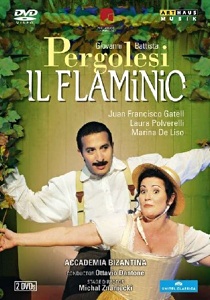
Giovanni Battista Pergolesi’s best known opera is La Serva Padrona, but the Neapolitan composer also composed several other works, which are now lovingly presented on DVD
by the Fondazione Pergolesi Spontini at Jesi. The composer was only 26 when he died, but works like Il Flaminio represent a clear link between the opera seria traditions of Handel and the Mozart/da Ponte comedy-dramas.
Il Flaminio can best be described as an opera buffa in plot and opera seria in music. The plot involves a series of mismatched lovers that have to find their way back to each other by the time the curtain falls. The musical structure, however, follows the opera seria pattern of secco recitative and aria da capo. As a result there the work sometimes feels disjointed—the characters are singing about rather frivolous romantic escapades while launching into dramatic, trumpet-like arias with extravagantly decorated verses and cadenzas. It would take composers like Mozart and Rossini to seamlessly weave lightness in the libretto with a corresponding lightness in the score.
The main storyline involves a love triangle between the widower Giustina (Marina De Liso) , who carries a torch for a man she once knew as Giulio (Laura Polverelli). He however now goes by the name of Flaminio and to complicate matters a rake named Polidoro (Juan Francisco Gatelli) loves Giustina as well. There are other romantic complications between several secondary characters as well. Pergolesi’s music is most inspired when writing for Giustina and Flaminio/Giulio. Perhaps the highlight of the opera is the long recognition duet between the two lovers in Act Two, “Se spiego i sensi mei.” Another highlight is a brief orchestral Tarantella in Act Two that added a bit of Mediterranean flavor to the opera.
At three hours, however, the opera feels too long by an act. After Giustina and Flaminio recognize each other, the drama of the opera loses its pulse and the rest of the opera feels like tying up the various loose ends of the plot. And, as I said, the rather constricted secco/aria da capo format doesn’t lend itself to this kind of light romantic comedy. The opera is worthy of revival for this occasion but one can also understand why it never became a true staple of the repertory.
This opera is performed in an absolutely tiny theater, and the orchestra is actually behind the stage platform, to allow for a maximum sense of intimacy between the performers and the audience. The “scenery” is really just a few props on a small wooden platform that suggest a bucolic Neapolitan countryside.
The stage directions follow the opera buffa traditions of sighing men, women appearing at balconies, and heavy doses of slapstick. There is quite an attempt to “open” the opera, including at one point inviting audience members onstage to sit in chairs to watch the performance during the puppet/dance show that accompanies the Tarantella.
The ensemble performers sing very well, with the possible exception of the scratchy-voiced Serena Malfi as Ferdinando. The Accademia Bizantina, led by Ottavio Dantone, sounded at times heavy-handed for this kind of opera, but again, the differences between the opera buffa plot and the opera seria style of the music is something that Pergolesi himself didn’t really resolve, so it’s not a surprise that the conductor never found the right mix of baroque formality and lightness.
The video is also available in Blu-ray format.


























Comments